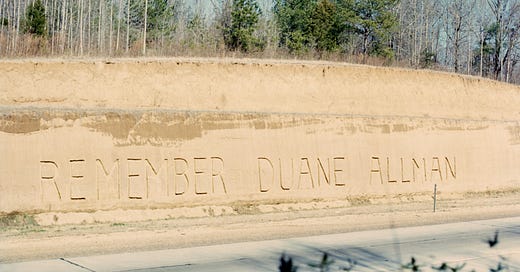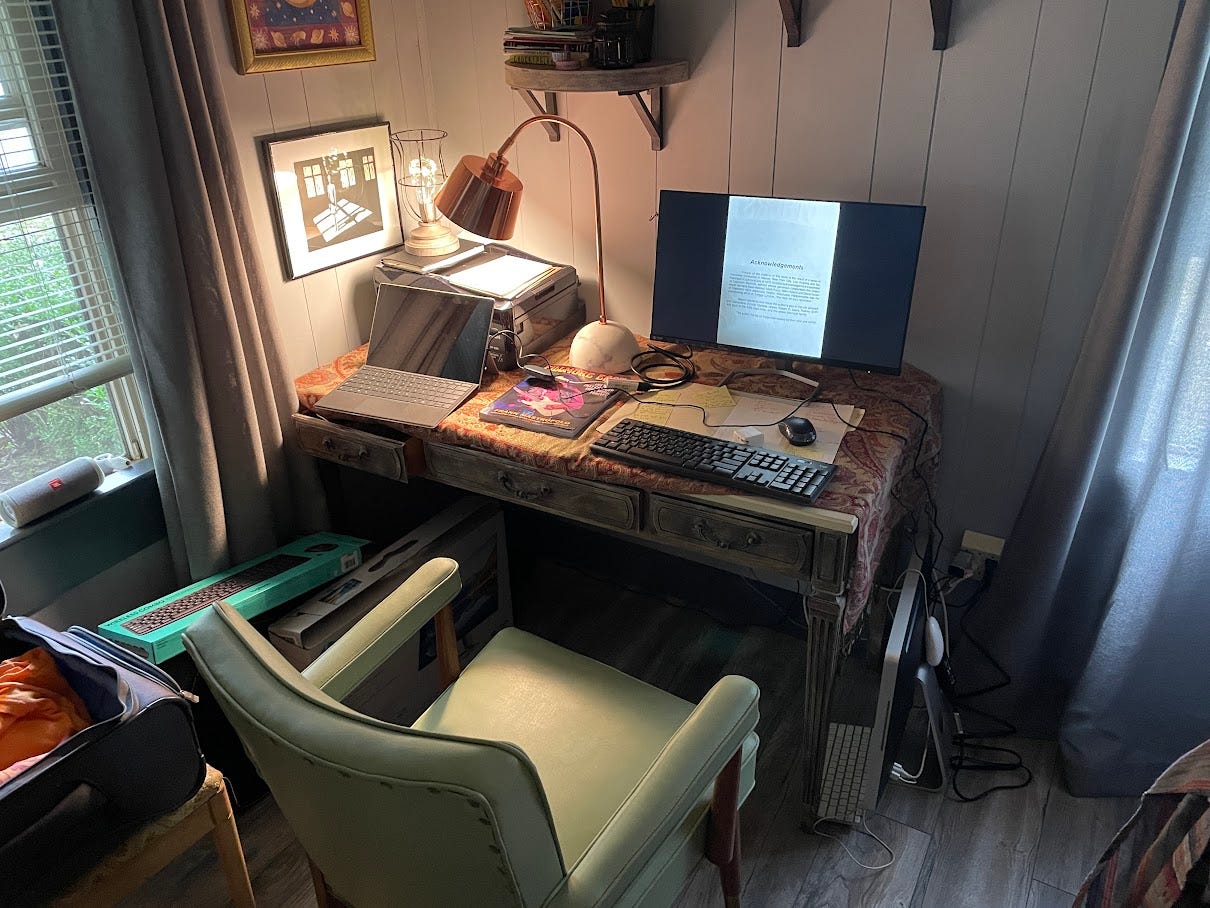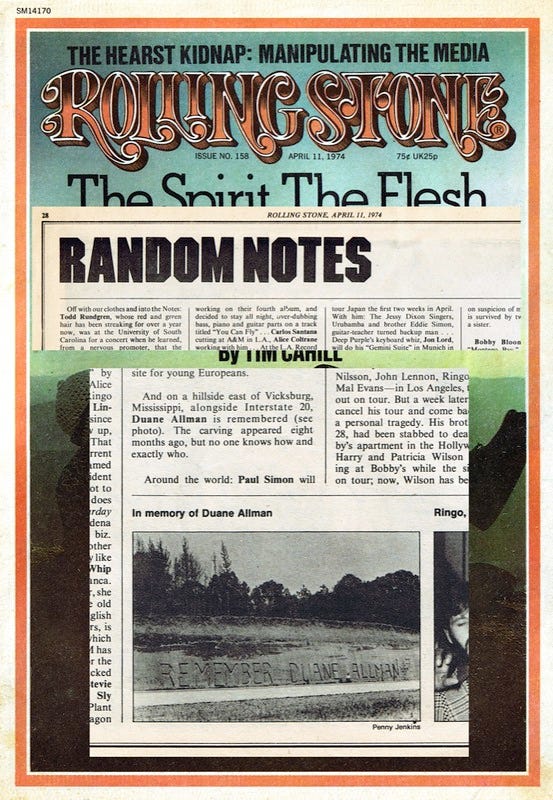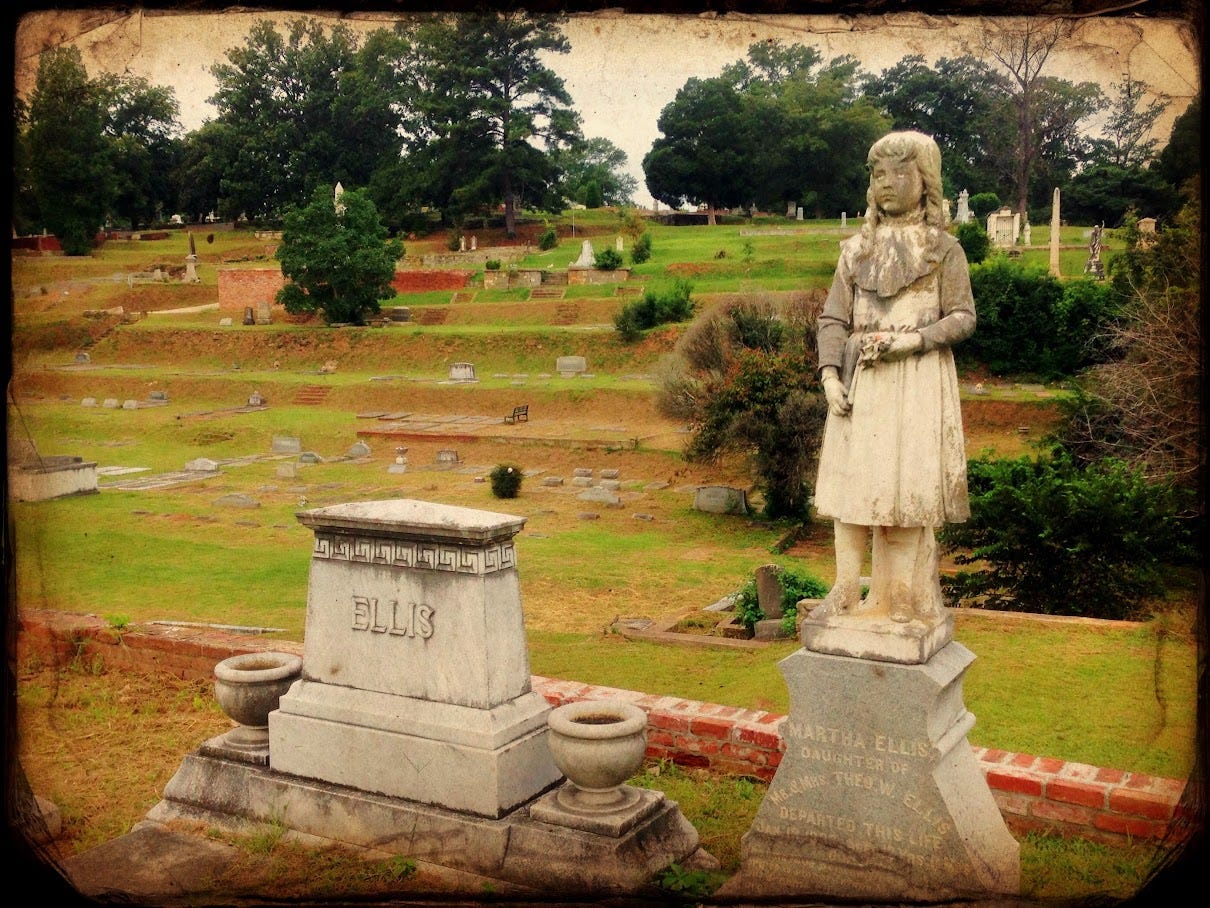Duane Allman was killed in a motorcycle accident October 29, 1971. Given all he accomplished in life, it’s hard to imagine he died at 24, on the precipice of superstardom.
Duane was the Allman Brothers Band’s their charismatic founder, leader, and (at the time) only acknowledged star. And many bands would’ve folded up shop at that very moment.
Instead, the ABB played what amounted to a gig at Duane’s funeral, finished up Eat a Peach, and embarked on a massive 90-day tour that saved the band and probably cost Berry Oakley his life.1
That the band lived on beyond Duane is really astounding to me.
I began chapter one, “Duane’s Musical Ethos” with this quote from Galadrielle Allman:
“My father is killed in the first paragraph2 of every article ever written about him. His life story is told backwards, always beginning at the end: in the road, his motorcycle down, his body broken. People linger over the wreckage as if it says something meaningful about his life.”
Focusing on Duane’s death, she argues, misses the point altogether. “Duane Allman’s story is more than a tragedy.... It is a true romance. He fell in love with his guitar and gave his heart away.”3
This is the true essence of Duane’s story.
His legacy isn’t the “what if” of his tragically rock ’n’ roll death at twenty-four; it is what he accomplished in music. It is larger than his stellar career or the success of At Fillmore East; it is how he conceived of and built a band that fulfilled the sound he heard in his head.
That is also what I mean by “Long Live the ABB.” The band didn’t die with Duane, and that’s a helluva legacy.
My thoughts from Play All Night
There's a million things I want to say, have said, have thought about, have read about this anniversary. Every writer who approaches this story had to consider how she or he was going to write about it, me included.
Here's where I ended up in Play All Night (p190-1).4
Duane’s accident was the result of a tragic combination of unbounded, infectious energy and self-destructive tendencies. Duane was as uninhibited personally as he was improvising on stage. His death came as no shock to many. “He had literally flirted with death too often to be surprised,” Jon Landau wrote.
Duane may not have had a death wish, but his recklessness sure left that impression. Landau observed, “No matter how briefly you knew him or how little, the more you got to know him, the more you realized that underneath the energy, the humor, the mock arrogance, proof and the real arrogance, was a troubled man who knew just how talented he was, but who didn’t know how to live at peace with that talent. In some ways the world wasn’t ready for him. And in others, he just wasn’t ready for it.”5
“Don’t bet everything on this pony because I’ll tell you, I’m going to live on the edge,” Duane told Walden. “I’m going to get every damn thing I can out of life every damn day. I’m not a safe bet. I don’t think I’ll live a real long time.” Walden explained, “He wasn’t saying it in any morbid way. He was just stating it like a fact of life.”
When Walden praised Duane at their last meeting, Duane responded, “That’s the scary part. I don’t know if I can get any better.”6
Butch Trucks recalled that Duane began to talk openly with his bandmates about life without him after he returned from King Curtis’s funeral in August 1971. “If anything ever happens to me,” he told the band, “you guys better keep it going. Put me in a pine box, throw me in the river, and jam for two or three days,” he said.
The relentless pace finally caught up to Duane on October 29, 1971. Three days later, the band performed at Duane’s memorial service at Snow’s Funeral Home in Macon. It was a fitting tribute to their fallen leader. The set featured “Statesboro Blues,” “Stormy Monday,” and “In Memory of Elizabeth Reed” from At Fillmore East and two blues standards they rarely played again, “Key to the Highway” and “The Sky Is Crying.” Delaney Bramlett led mourners in the Carter Family standard “Will the Circle Be Unbroken.” Gregg dedicated his ballad “Melissa” to Duane.
From Play All Night! Duane Allman and the Journey to Fillmore East
About that roadside memorial
It was located, artist G. David Reid wrote to Rolling Stone, “Six miles east of Vicksburg, beside the west-bound land of Interstate 20 is a monument to the spirit of Duane Allman, the guitarist. It reads simply: REMEMBER DUANE ALLMAN. Hand-carved in a wall of earth, it stands ten feet above the ground level, the letters themselves averaging seven feet in height and the entire message over one hundred feet in length.”7
In his letter, which Rolling Stone never printed, Reid admitted the idea wasn’t original. Reid had seen “a similar statement painted on a fence in Georgia [and] a water tower in Arkansas.” Local (Vicksburg) efforts included “carving the words on dirt banks, though none had survived the weather and were already crumbling.”
Reid and four friends carved the memorial on February 3, 1973 “west of a truck scale or weigh station one mile west of Bovina, Mississippi.” The entire project took about 4.5 hours to complete.
It stood for more than a decade but is long-gone.
This is an example of an impromptu public memorial
Memory is a corollary of history, how we think about and remember the past—collectively and individually.8
This 1973 roadside memorial shows how four southerners honored Duane in the immediate wake of his death. Since then, Duane has had countless other memorials. Since the early 70s, many have made the pilgrimage to Rose Hill Cemetery to pay our respects to (first) Duane and Berry and now Butch and Gregg.
Duane’s adoptive hometown of Macon boats the Big House Museum9, Duane Allman Memorial Boulevard, and several public murals in his honor. Macon’s music community is also his legacy.
And, of course, the Allman Brothers Band began its final show on October 28, 2014, playing their final notes in the wee hours of the following morning, the anniversary of Duane’s.
It is that living legacy I commemorate and choose to focus on on October 29 of each year. #longlivetheABB
Little Martha is also an example of how memory and actual history conflict.
At some point in the late 80s, a rumor circulated that a statue of Martha Ellis at Rose Hill inspired Duane’s song title. It has hardened somewhat into legend Truth is, Duane wrote “Little Martha” for his girlfriend at the time: Dixie Meadows. Nevertheless, many of us (myself included) pay their respects to Martha Ellis when visiting Rose Hill.
Random Notes
More Little Martha.
“Little Martha” was Duane’s only solo composition and it was fitting that his beautiful acoustic instrumental ended Eat a Peach, the album that was Duane’s elegy.
Taking a cue from Gregg’s 1974 Gregg Allman Tour shows,10 the ABB played “Little Martha” over the house PA at the tail end of every show beginning in the 90s.
Duane’s headstone is engraved with notes to “Little Martha.” Though I understand it’s in a different key than the original.
The ABB opened its final show with “Little Martha” (10/28/14)
Langiappes
Here are some cool versions of Little Martha:
A “Little Martha” outtake with Berry Oakley on bass that appeared on Dreams.
Acoustic guitar virtuoso Leo Koettke first covered “Little Martha” in 1986.
Here’s Derek Trucks and Jerry Douglas from 2/29/20 at the Ryman.11
I’ll leave you with one more
…a string quartet from Macon’s Mercer University playing “Little Martha” at Rose Hill in 201412
If you enjoyed this post, please share it with at least one person.
I’ll make it easy for you
This is conjecture on my part, of course. Who knows what would’ve happened had everyone in the band had today’s understanding of mental health in 1971?
I was careful to avoid this trap, an admonition from my dissertation committee member Kris McCusker.
Galadrielle Allman, Please Be with Me: A Song for My Father, Duane Allman (New York: Random House, 2014). This is a must-have book in any ABB collection. Trust me, I’m a doctor.
Completed in Muscle Shoals (where it all began for Duane) on 10/29/2021, the 50th anniversary of Duane’s death. This was not on purpose, it was how the schedule played out. Truly #mushroommagic in action.
Landau was an early chronicler of the ABB. He’s been working with/for Bruce Springsteen for years.
This quote always gets me.
Erica Reid, Remembering Dad Remembering Duane Allman.
History/memory is a really important distinction for historians and, frankly, citizens as a whole. In addition to what I’ve written on Substack see also, “No Sooner Was It Over, than the Memory Made It Nobler” in Controversial Monuments and Memorials (2023); “Alive in Our Imagination: The Sesquicentennial of the American Civil War” in The AASLH Guide to Commemoration (2017).
Like here at Long Live the ABB, the Big House honors the ENTIRE ABB. Its entire genesis began as the archive of a single devoted fan, the Tour Mystic, Kirk West.
Queued it up for you: “Little Martha” over P.A. from the Gregg Allman Tour.
It was TTB’s last show for more than a year. I’m still dealing with that sudden withdrawal 🍄.
These are students Mercer University’s McDuffie Center for Strings. Located at the site of the ABB’s first album cover photograph. NB: the first :44 seconds of this video perpetuate the “Little Martha” myth.






